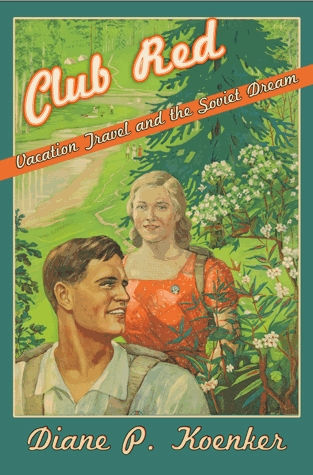
There have been a lot of books written about the socialist experiment in the Soviet Union. Most fall into the dominant Cold War, anti-communist mold. But others are considerably more balanced, nuanced and objective. Diane P. Koenker’s unique Club Red: Vacation Travel and the Soviet Dream falls into the latter category.
While still critical of shortcomings, failures and structural mismanagement within the Soviet planned economy, Koenker also paints a vivid, detailed picture of a government sincerely attempting to live up to its promise of “the good life” for its citizens – one aspect of-which is the right to a vacation.
Koenker writes, “… the process of becoming a tourist, learning how to take a socialist vacation, constituted one of the paths towards consuming the Soviet good life.” As consumers, she says, “Soviet vacationers expected to receive cultural uplift and education.” In fact, “The quest for meaning in leisure travel, in both tourism and rest, constituted an important part of the purposeful Soviet vacation experience.”
However, Koenker adds, Soviet “tourism and vacation policies and practices explicitly encouraged the celebration of individual autonomy in a state founded on collectivist principles.” She calls this “the paradox” at “the heart of” the Soviet vacation and tourism industry. This unique paradox helps to shatter the widely believed anti-communist myth of a collective despotism determined to destroy all remnants of the individual.
Unlike in the western capitalist world, where vacation is considered a luxury available only to those who can afford it, in the former Soviet Union vacation was a right every person was entitled to.
This, however, did not mean that everybody got to go on vacation, or experienced vacation in the same way.
Vacationers received vouchers, which “entitled the recipient to a course of treatment, food and lodging at a designated institution for a particular period of time.” The voucher “possessed a monetary value that represented the sum total of food and services to be provided.” Vouchers were distributed “by criteria other than price,” meaning a person’s ability to afford the vacation wasn’t the main factor determining who should receive the voucher.
In most instances, vouchers were distributed by the local trade union or factory committee. Officially industrial workers were given priority due to the physically demanding nature of their work. The Central Trade Union Council “directed that 80 percent of sanatorium [health vacation resorts] places should be reserved for workers.” However, as records indicate, this wasn’t always the case, and those who misused a worker’s voucher were often sent home, shamed in the press and sometimes faced criminal prosecution.
Like their western counterparts, especially as World War II neared, Soviet vacation planners faced “shrinking capacities” and “[f]inancial difficulties … resulting particularly in the inability to recruit and retain” skilled vacation staff, cooks, hosts, tour guides, etc. However, even under conditions of budgetary cutbacks, “universal access most markedly distinguished proletarian tourism from comparable practices in the capitalist world,” as the “socialist state would subsidize its tourists, especially those with the fewest resources to travel” by negotiating with transportation agencies and constructing inexpensive tourist lodging, among other examples.
Understandably, during World War II Soviet leaders redirected their attention away from vacation and tourism, away from creating “the good life,” to focus on saving their nation from the Nazi onslaught. It wasn’t until July 1945 that the right to a vacation was reinstituted.
After the war, with its terrible toll on the Soviet people, the government faced a dilemma. Koenker writes, “Recognizing that not all deserving workers could immediately regain their right to rest, Soviet authorities stipulated that … priority should be given to invalids from the war, pregnant women and nursing mothers, [and] workers in hazardous branches of work.”
According to Koenker, as “the Soviet standard of living continued to rise” vacation time also increased. “The Soviet working person could now expect an annual three-week vacation.” Currently, in the United States the average paid vacation is two weeks; however, most vacationers take less due to fear of losing their jobs. And it should also be noted that a large percentage of Americans do not receive any paid vacation time off at all.
While the Soviet experience was far from perfect, there is a lot we can still learn from their experience with vacation as a right, as this book shows.
Club Red: Vacation Travel and the Soviet Dream is a fascinating read. Although parts of the book can be a little tedious due to the use of too much statistical information, Club Red is a welcome addition to the history of the socialist experiment in the Soviet Union. And Koenker does an excellent job of balancing the government shortcomings and failures with the promise of “the good life,” in which every Soviet citizen could enjoy vacation travel and tourism – a promise our political leaders never make.
Book information:
Club Red: Vacation Travel and the Soviet Dream
By Diane P. Koenker
Cornell University Press, 2013, 328 pages
Available in hardcover and ebook

MOST POPULAR TODAY


Zionist organizations leading campaign to stop ceasefire resolutions in D.C. area

High Court essentially bans demonstrations, freedom of assembly in Deep South

Communist Karol Cariola elected president of Chile’s legislature

Afghanistan’s socialist years: The promising future killed off by U.S. imperialism






Comments